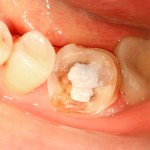
Root canal treatment (RoCT) is a common dental procedure and an understanding of the survival of RoCT teeth and their restorations is an important consideration. The aim of this review was to assess the success rates for single crowns, fixed and removable dental prostheses, as well as for the different kinds of posts placed on RoCT teeth, and to address the most common reasons for failure in these restorations.
Only PubMed was searched for this review with additional searches of identified papers. Clinical studies with at least 6 years follow-up were included.
- Four studies were included (2 prospective, 2 retrospective)
- The success rate after 6 years
- For single crowns [4 studies] was 92% (95% CI 82–98%)
- For fixed dental prostheses [2 studies] was 79% (95% CI 72–86%)
- For single crowns only success rates
- with posts – 92% (95% CI 82– 98%)
- with no posts 94% (95% CI 84–99%)
- The commonest reason for failure for was dislodgement of the post-and-core and crown, followed by root fracture and periapical inflammation
The authors concluded
Single crowns appear to be the best treatment modality for RoCT teeth. However, the overall evidence is weak and studies heterogeneous. The low number of studies and their unfavourable design limit the validity of the results presented in this systematic review.
Comment
While this review does provide some interesting information. It is not technically a systematic review as only a single database was used. Consequently it is likely that the use of additional databases would have identified additional relevant papers. Limited information on the inclusion criteria was provided and there is no information on quality assessment of the papers. The meta-analysis has combined both pro and retrospective designs. As the authors note review by Stavropoulou & Koidis 2007 and Torabinejad et al 2007 have also looked at outcomes of dental restorations on RoCT teeth. While Ng et al 2010 have considered tooth survival following non-surgical RoCT. Specific review on the performance of root canal posts are also available ( see Dental Elf –March 6th 2012).
Links
Ploumaki, A., Bilkhair, A., Tuna, T., Stampf, S. and Strub, J. R. (2013), Success rates of prosthetic restorations on endodontically treated teeth; a systematic review after 6 years. Journal of Oral Rehabilitation. doi: 10.1111/joor.12058
Stavropoulou AF, Koidis PT. A systematic review of single crowns on endodontically treated teeth. J Dent. 2007 Oct;35(10):761-7. Epub 2007 Sep 5. Review. PubMed PMID: 17822823.
Torabinejad M, Anderson P, Bader J, Brown LJ, Chen LH, Goodacre CJ, Kattadiyil MT, Kutsenko D, Lozada J, Patel R, Petersen F, Puterman I, White SN. Outcomes of root canal treatment and restoration, implant-supported single crowns, fixed partial dentures, and extraction without replacement: a systematic review. J Prosthet Dent. 2007 Oct;98(4):285-311. Review. PubMed PMID: 17936128.
Ng YL, Mann V, Gulabivala K. Tooth survival following non-surgical root canal treatment: a systematic review of the literature. Int Endod J. 2010 Mar;43(3):171-89. doi: 10.1111/j.1365-2591.2009.01671.x. Review. PubMed PMID: 20158529.

It was really an healthy review of root canal treatment. If done properly you may not feel any pain in the early stages of the infection. In some cases, your tooth could darken in color, which may mean that the nerve of the tooth has died .